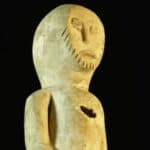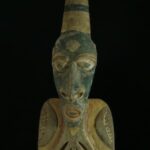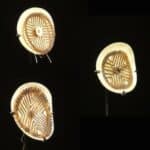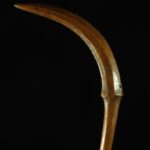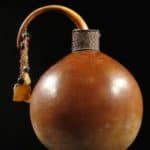Micronesian Mattang Navigation chart
Micronesian Mattan For sale.



Near identicle example in the Penn Museum


Object Type: Micronesian Navigation Chart
Locality: Micronesia
Circa: 1950’s
Material: Sennit fiber, cowrie shell, and palm frond midrib
Dimensions across tooth: 65 cm
Description
An almost identical example was given to the H. Davenport by James Milne, a fully trained Marshallese navigator, from Ebon Island in 1958. That example is now in the Penn Museum. The examples are so similar I think there is little doubt that they are by the same hand.
It is a remarkable example for on it are represented four (two is the usual number) different swell patterns, their reflections
Each swell pattern is represented by a pair of opposed curved sticks, between which is laid a straight stick with a notched figure near each end. One straight stick has a third notched figure at the center. At all ends but one of the swell representations is a pair of shorter crossed sticks that represent the interaction of the two adjacent swell patterns on the one represented by that to which the short pair is lashed.
The odd end that has two uncrossed sticks represents the direction of sunrise, the cardinal direction for the Marshallese, from which come the Tradewind and the dominant swell.
All elements of the model are arranged into an octagonal composition. The eight marginal sticks forming the sides of the octagon and the undecorated straight sticks that connect the corners constitute the supporting frame only and represent nothing.
In reading this training model, the center can represent an island, and the bent sticks illustrate refractions of waves approaching it from many directions. The cowrie (Cypraea sp.) shells tied at the center point of each side can also represent islands, and the crossed sticks by them illustrate either interaction of other refracted waves or the turbulence that is found in the lee of an island as a swell is bent around it.
Price $1600




